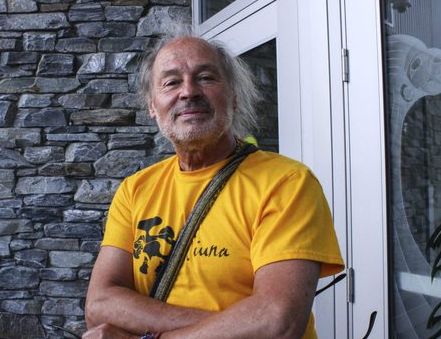 Guy Sioui Durand standing outside the Songhees
Guy Sioui Durand standing outside the Songhees
Wellness Centre on Lekwungen territory during
the PC/Cp Gathering 2017.
Photo credit: Naomi Kennedy.
I moderated the workshop Diversity in Québec with the magnificent Zab Maboungou, feeling our hot topic was sure to draw a lot of energy. To get to our small meeting room, we had to take a staff elevator to the second floor. Couch, table, a few chairs, and a blackboard—that was it. Enough room for maybe 12 people. And we certainly filled the space.
I was nervous. I had planned to start the discussion on diversity in Québec in a low-key fashion, by making a few open-ended and positive comments. The blackboard would come in handy to jot down a few key words.
I began by describing the complex nature of cultural diversity in Québec, the numerous overlapping cultural territories, and the need to explore them, to go back-and-forth. I am Wendat, and more broadly a member of one of the 10 First Nations in Kébeq—Mig’ma
kw, Wolustuk Malécites, WabanA’kis, Kanien’ke ah :ka (Mohawks), Atikamekw, Innus, Eeyou Itshee, Naskapis, Anishinaabes, in addition to the Inuit in Nunavik. As I see it, intercultural borders—including the growing phenomenon of revitalizing Indigenous languages; the merger of crafts and experimental creation; customary use giving way to storytelling, music, documentaries, the emerging data transmission market, and in-situ multimedia installations—overlap a vast territory unknown to city dwellers. I was happy to talk about it. That’s why I described Indigenous diversity with permeable borders open to exchanges and joint projects among artists (although geographically distant and despite a great deal of ingrown prejudices).
By taking this approach, I set the stage for as many people as possible to share their experiences.
Zab Maboungou, a high-octane dancer and drummer, energetically described the unique multicultural ambience of Tiötià :ke (Montréal), referring first of all, the cosmopolitan mix of migrant artists from all over Yandiäwish, the Giant Turtle (European, African, So
uth America, Asian, and Oceanian), and then to the longstanding split between francophones and anglophones which carries over to cultural institutions and spaces. This background not only weakens the few relationships that Québec institutions maintain with Indigenous artists, but also creates a host of other problems: inequality, lack of integration, cultural appropriation, and the inadequacy of the various arts council support programmes.
The discussion quickly became heated, as did our little room. People kept coming to the door and looking in, no doubt wanting to join the conversation, but there was no space.
We ended up running out of time. We could have filled two sessions with all the passionate points of view flying back and forth. “Indian time” did prevail in that we used up every last minute of our schedule for people to share their experiences—I’m thinking, for example, of the story shared by the Colombian artist, Frida Kahlo.

Guy Sioui Durand
Tsie8ei
8enho8en
Translated by Don Sugden, reviewed by Breanna Fabbro.

Guy Sioui Durand is a Wendat (Huron) based in Wendake, Québec, Canada. He is a sociologist (PhD), art critic, independent curator, and performer (spoken word). He is specialized in contemporary Aboriginal art and contemporary art. Sioui Durand is curating the project Hommage aux Skywalkers/Ironworkers Mohawks from the event Rassemblement Internations d’Art Performance Autochtone (RIAPA) in Wendake this September 14-16, 2018. He is preparing the exhibition De Tabac, de Sauge et de Foins d’odeurs for the Joliette Museum of Art for winter 2019. Sioui Durand teaches "Initiation to Modern and Contemporary Aboriginal Art" at the Kiuna Native Institution, the only completely Aboriginal post-secondary institution.